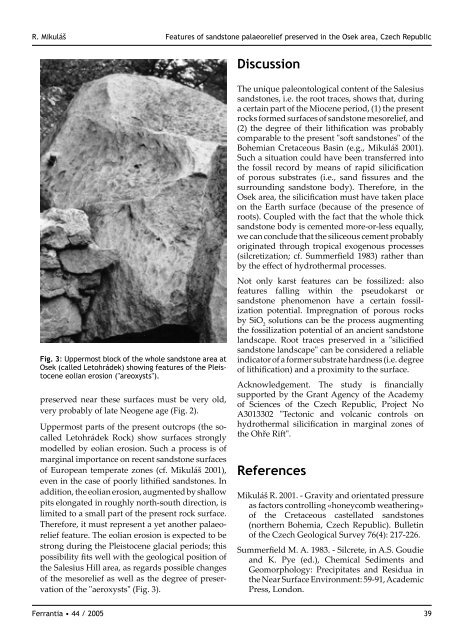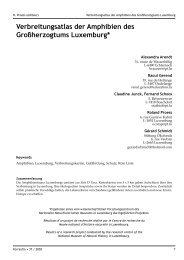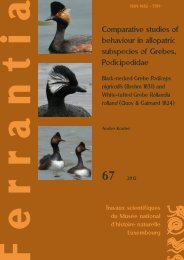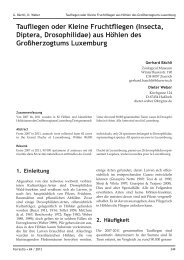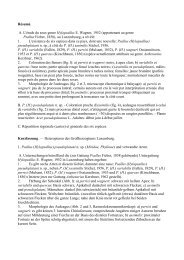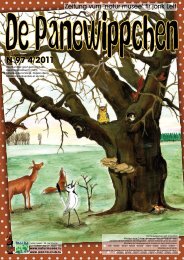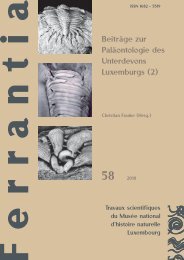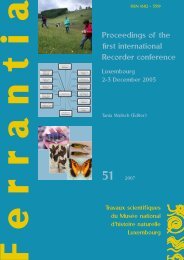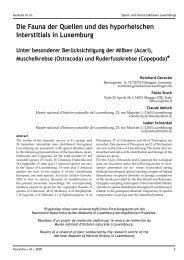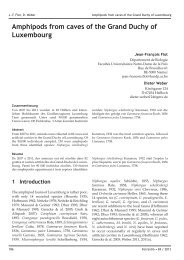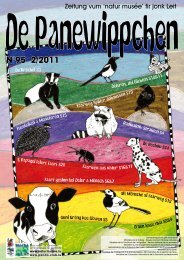Publi.complète - Musée national d'histoire naturelle
Publi.complète - Musée national d'histoire naturelle
Publi.complète - Musée national d'histoire naturelle
Create successful ePaper yourself
Turn your PDF publications into a flip-book with our unique Google optimized e-Paper software.
R. Mikuláš Features of sandstone palaeorelief preserved in the Osek area, Czech Republic<br />
Fig. 3: Uppermost block of the whole sandstone area at<br />
Osek (called Letohrádek) showing features of the Pleistocene<br />
eolian erosion ("areoxysts").<br />
preserved near these surfaces must be very old,<br />
very probably of late Neogene age (Fig. 2).<br />
Uppermost parts of the present outcrops (the socalled<br />
Letohrádek Rock) show surfaces strongly<br />
modelled by eolian erosion. Such a process is of<br />
marginal importance on recent sandstone surfaces<br />
of European temperate zones (cf. Mikuláš 2001),<br />
even in the case of poorly lithified sandstones. In<br />
addition, the eolian erosion, augmented by shallow<br />
pits elongated in roughly north-south direction, is<br />
limited to a small part of the present rock surface.<br />
Therefore, it must represent a yet another palaeorelief<br />
feature. The eolian erosion is expected to be<br />
strong during the Pleistocene glacial periods; this<br />
possibility fits well with the geological position of<br />
the Salesius Hill area, as regards possible changes<br />
of the mesorelief as well as the degree of preservation<br />
of the "aeroxysts" (Fig. 3).<br />
Ferrantia • 44 / 2005<br />
Discussion<br />
The unique paleontological content of the Salesius<br />
sandstones, i.e. the root traces, shows that, during<br />
a certain part of the Miocene period, (1) the present<br />
rocks formed surfaces of sandstone mesorelief, and<br />
(2) the degree of their lithification was probably<br />
comparable to the present "soft sandstones" of the<br />
Bohemian Cretaceous Basin (e.g., Mikuláš 2001).<br />
Such a situation could have been transferred into<br />
the fossil record by means of rapid silicification<br />
of porous substrates (i.e., sand fissures and the<br />
surrounding sandstone body). Therefore, in the<br />
Osek area, the silicification must have taken place<br />
on the Earth surface (because of the presence of<br />
roots). Coupled with the fact that the whole thick<br />
sandstone body is cemented more-or-less equally,<br />
we can conclude that the siliceous cement probably<br />
originated through tropical exogenous processes<br />
(silcretization; cf. Summerfield 1983) rather than<br />
by the effect of hydrothermal processes.<br />
Not only karst features can be fossilized: also<br />
features falling within the pseudokarst or<br />
sandstone phenomenon have a certain fossilization<br />
potential. Impregnation of porous rocks<br />
by SiO solutions can be the process augmenting<br />
2<br />
the fossilization potential of an ancient sandstone<br />
landscape. Root traces preserved in a "silicified<br />
sandstone landscape" can be considered a reliable<br />
indicator of a former substrate hardness (i.e. degree<br />
of lithification) and a proximity to the surface.<br />
Acknowledgement. The study is financially<br />
supported by the Grant Agency of the Academy<br />
of Sciences of the Czech Republic, Project No<br />
A3013302 "Tectonic and volcanic controls on<br />
hydrothermal silicification in marginal zones of<br />
the Ohře Rift".<br />
References<br />
Mikuláš R. 2001. - Gravity and orientated pressure<br />
as factors controlling «honeycomb weathering»<br />
of the Cretaceous castellated sandstones<br />
(northern Bohemia, Czech Republic). Bulletin<br />
of the Czech Geological Survey 76(4): 217-226.<br />
Summerfield M. A. 1983. - Silcrete, in A.S. Goudie<br />
and K. Pye (ed.), Chemical Sediments and<br />
Geomorphology: Precipitates and Residua in<br />
the Near Surface Environment: 59-91, Academic<br />
Press, London.<br />
39


